
Use the "hamburger" menu icon at the top right of your screen to view and go directly to a topic.
If you have any mobile signal problems try downloading the page to your mobile device for offline viewing.
WELCOME
Prayer, Witness and Service
St Catherine's is part of the Waterside Group of Churches (Benefice), we are a group of church communities committed to following Jesus and sharing his love in the heart of the Norfolk Broads.
Our three parish churches are All Saints', Catfield, St. Catherine’s, Ludham and St. Nicholas, Potter Heigham, and we are committed to providing a warm welcome to all members of the community and our many visitors.
We do this through prayer, visible witness and practical involvement in our individual parishes and in our community. The Waterside Group has a deep desire to show the Grace of God in its community, guided by the example of Jesus Christ.
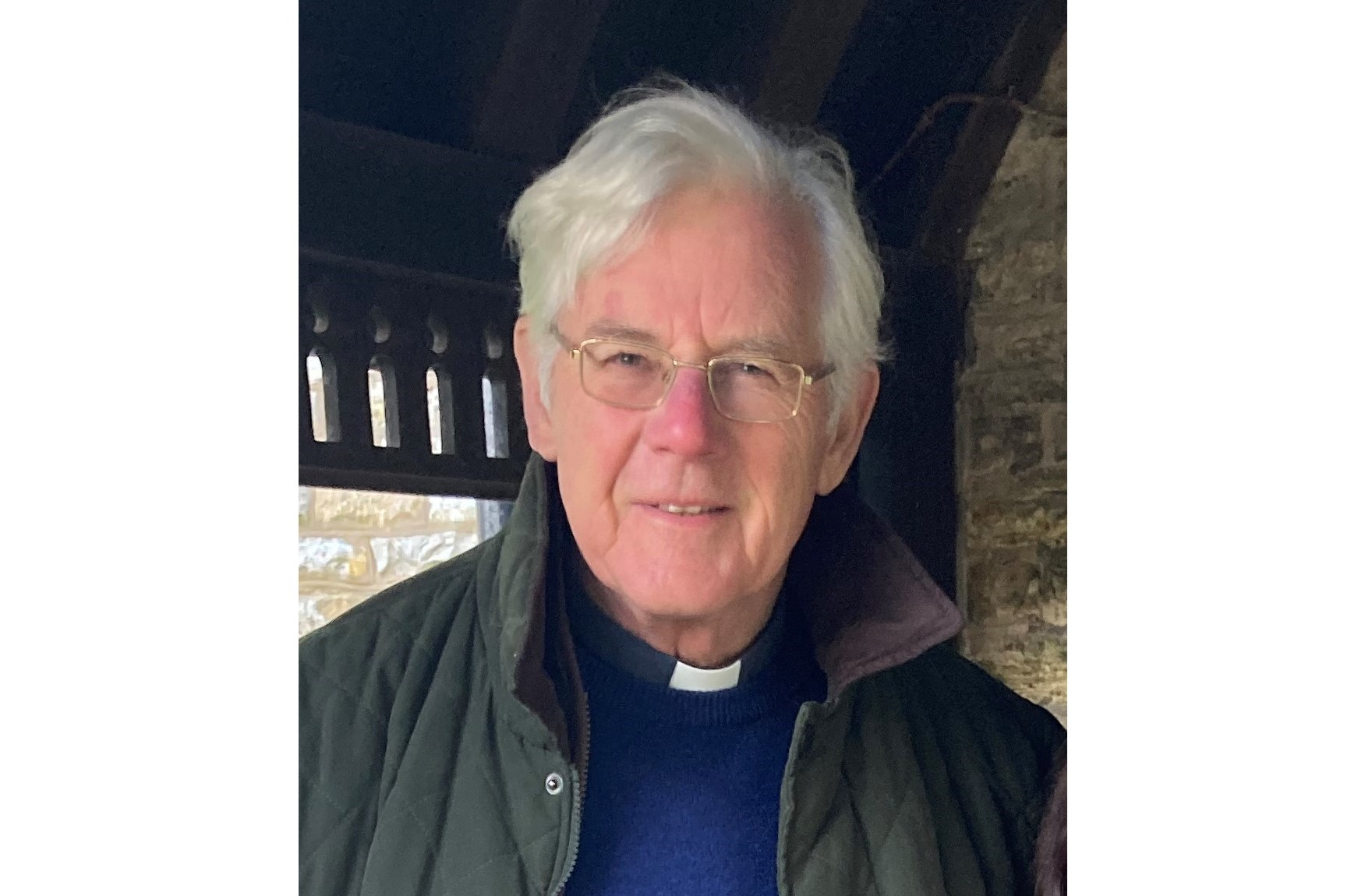
The Reverend Gary Noyes
Vicar of the Waterside Benefice
ST CATHERINE'S CHURCH LUDHAM
A Short History of St Catherine's Church
The church of St Catherine's is large for a village church. It is thought likely there was a church of some sort on this site from the 8th or 9th century, and mention is made of a church in Ludham in a charter of about 1047 from Edward the Confessor to St Benets.
Probably the church mentioned in 1047 was a lot smaller and could even have been built of wood, stone being scarce in Norfolk.
In medieval times the church of Ludham had close connections with the nearby Abbey of St Benet at Holme. Ludham being one of the three original Manors given by King Canute in 1019 to the small group of religious men which eventually became an important Benedictine monastery.
Norfolk thrived on the proceeds of the wool trade in medieval times, as did the wealth of St Benets. Which no doubt helped greatly in the rebuilding of the church in the 14th century, and further rebuild in the 15th century of the nave (the main body of the church) and side aisles, in Perpendicular style including a superb hammer-beam roof of oak.
Of the original 14th century building, only the clock tower and the chancel (the altar area) still remain.
Like a number of other churches St Catherine's undertook a great deal of restoration and repair during the Victorian era, including the installation of the present pew benches and pulpit.
Not to be missed and very rare is the female Woodwose on the font, and the Tympanum (the decorated area above the screen leading to the chancel) presently the subject of a great deal of research and thought possibly one of, if not the oldest, still existing in the country.
Housed in the Tower and not available for viewing we also have the second heaviest set of five bells in the county, and the monumental brass dated 1351 on the floor in the Lady Chapel is one of the oldest in Norfolk.
Myths and Legends - The Ludham Dragon
“Many years ago the good people of Ludham were shocked by the appearance of a hideous monster. It was said to have resembled a dragon or monstrous lizard. It was covered with scales and had wings. It’s frightful mouth was rendered formidable by tremendous teeth. It was supposed to measure from 12 to 15 feet in length. As it was only visible after sunset, none dared to leave their houses when it was dark.
 The Ludham Dragon, (just inside the North Door), made and presented by Brenda Dennis, local Ceramic Artist.
The Ludham Dragon, (just inside the North Door), made and presented by Brenda Dennis, local Ceramic Artist. The Dragon, or monster as some would call it, formed a large burrow which was known to extend from the yard at the back of the local public house to just past the old school house. Every morning the exit was filled up with bricks and stones, and then as often, reopened at night by the monster.
One bright sunshiny afternoon, to the horror of the inhabitants, it was seen to leave the burrow. As soon as it had got some distance away, a courageous parishioner dropped a single large round stone into the mouth of the burrow, completely filling it up.
After basking in the sun for some time the monster returned. Not being able to remove the stone it turned away bellowing and lashing its sides furiously with its tail. It then made its way across the fields in the direction of the Bishop’s Palace. Turning to the left it made its way along the dreary causeway leading to the ruined St Benets Abbey Gateway. Round and round it ran, throwing up stones and dirt in its fury and raising its hideous form up against the ruined walls, at last it entered the gloomy archway where it is supposed to have made its way to the vaults beneath and was no more seen.
After a time the burrow was carefully filled up. To the satisfaction of the parishioners, there has been no return of the Ludham Dragon”.
Collected by William Henry Cooke in 1911, now held by the Norfolk Record Office.
See if you can spot what looks like a "Dragon's" head at the top of the pillar to the left of the Rood Screen.
The 15th Century Font
The font in Ludham Church is a typical 15th Century East Anglian one, however it is very unusual as it has two Woodwoses, that for the female being very rare, carved on its pedestal.
The eight sided font, in ecclesiastical symbolism, is the sign of regeneration and is used for Baptisms (or Christening as it sometimes called). Round the top of the font are carved the symbols of four Evangelists; the winged Angel of St Matthew; the winged Lion of St Mark; the winged Ox of St Luke and the Eagle of St John.
It is unusual in having a double corona, which is the part between the symbols of the four Evangelists and the pedestal below.
The upper corona has grotesque figures, with hideous faces and half-folded wings. Thought to represent the evil spirits expelled by Baptism, and below these angels, each holding a mystical instrument, to represent the heavenly choir welcoming the new-born soul.
These symbols and carvings are not unexpected features of a font, but carved lower down on the pedestal are two seated lions and two less than usual larger figures called Woodwose, a male and very rare a female, both wearing skins and carrying clubs. Both have longish hair and the man has a beard carries a shield These two figures are a sort of hangover from pagan times. presumably representing unregenerate man and woman.
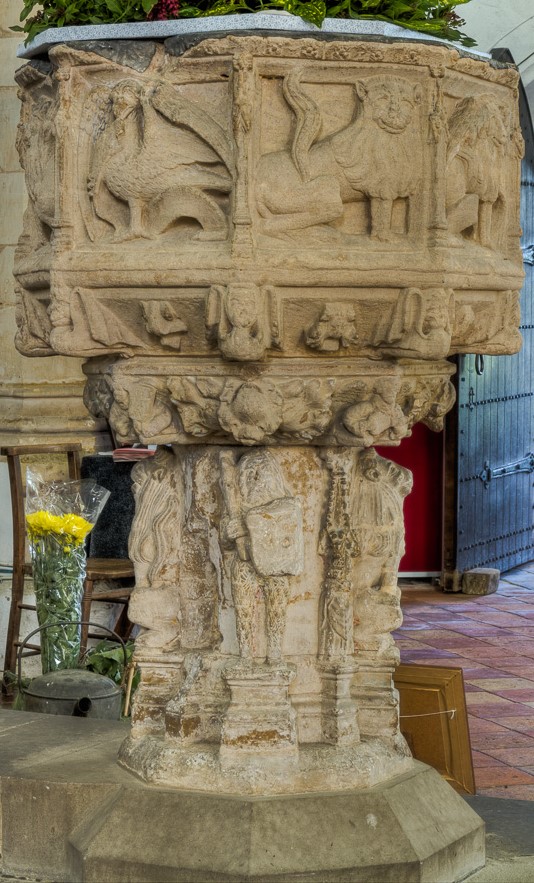
It is the female figure that makes this font virtually unique.
Female Woodwose are extremely rare, only existing on ancient tapestries and glass. This figure carries a huge club, like her partner, but no shield. Her hands protrude from the fur, unfortunately her feet were damaged at the time of the reformation.
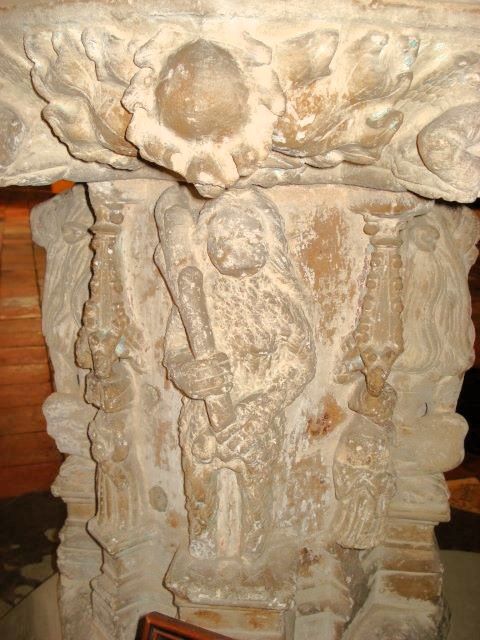 Called Woodwose, Woodhouse, Woodwo or Wild Men or Women, or sometimes Green Men or Women. The figures are semi-humans who feature in Roman and Greek mythology, and were also popular mediaeval folklore figures, dressing in a lion's skin and in this case carrying a heavy club and shield. These strange figures are seen far more in Norfolk and Suffolk than in any other county.
Called Woodwose, Woodhouse, Woodwo or Wild Men or Women, or sometimes Green Men or Women. The figures are semi-humans who feature in Roman and Greek mythology, and were also popular mediaeval folklore figures, dressing in a lion's skin and in this case carrying a heavy club and shield. These strange figures are seen far more in Norfolk and Suffolk than in any other county. The book of Isaiah (13, 2) in the old Testament, makes mention of such 'doleful creatures and satyrs' and in medieval times it was widely believed that such creatures of the imagination lurked in the dark woodlands covering England.
On the pedestal between the lions and the woodwoses are three figures; the Abbot of St Benet's, a mother and child representing baptism, and a deacon or sub-deacon and, plus a space where an unknown figure once stood.
The Church Tower
The Tower was built in the 14th century, the same period as the Chancel.
At ground level are the recently installed kitchen and toilets, on top of this is the bell ringing floor, from which leads a narrow and steep circular staircase to the floor above housing the tower clock, a ladder from there leads up to the platform and frame holding the church bells.
Coffee Shop - Kitchen and Toilets
At the base of the Church Tower a kitchen along with toilets were installed in 2020 using green oak.
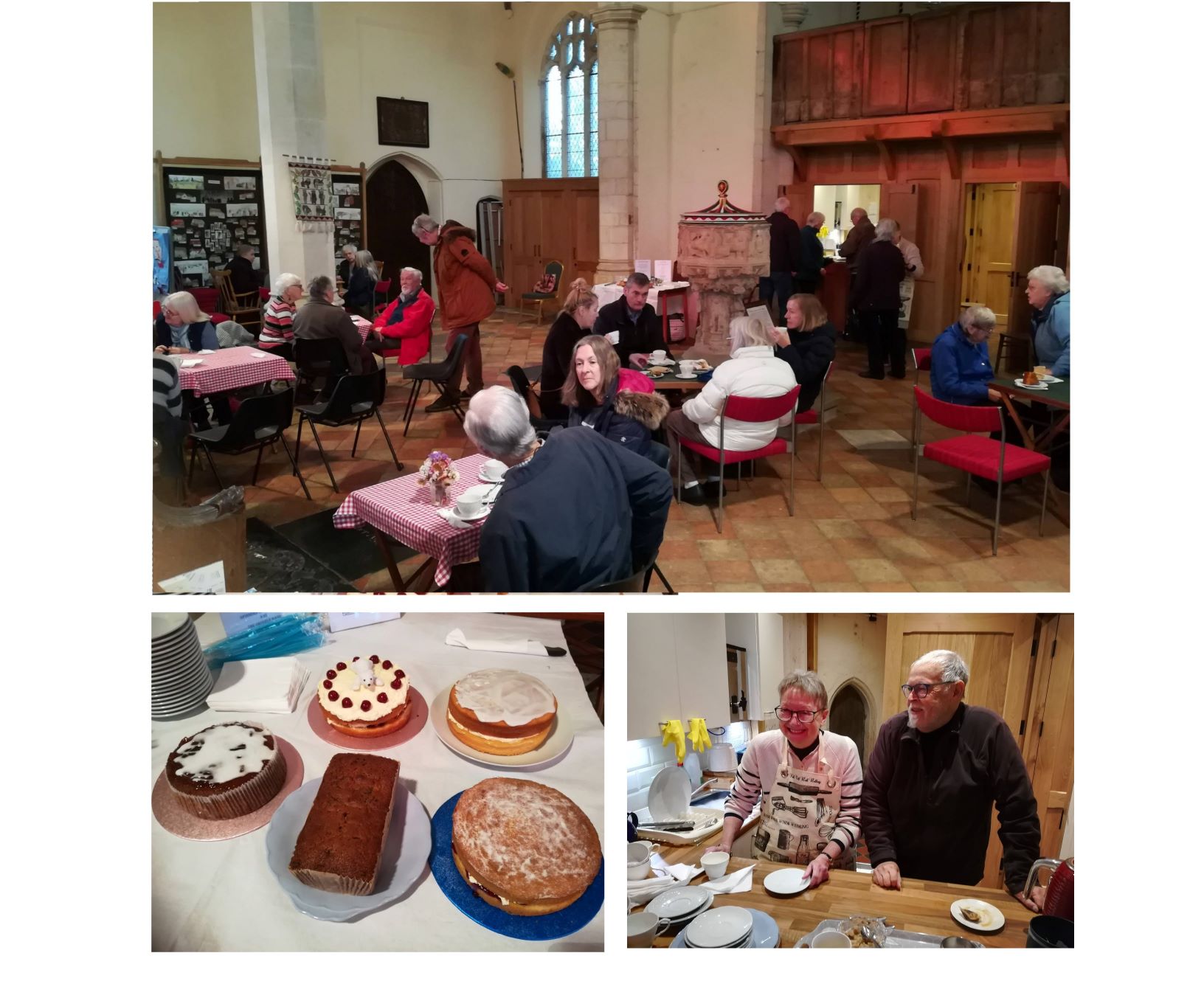 The kitchen is used after church services to provide refreshments to the congregation, >and is also open every Friday morning from 10am to noon throughout the year as a very successful Coffee and Tea and cake shop, providing a regular year round place to gather and chat for villagers and visitors.
The kitchen is used after church services to provide refreshments to the congregation, >and is also open every Friday morning from 10am to noon throughout the year as a very successful Coffee and Tea and cake shop, providing a regular year round place to gather and chat for villagers and visitors. Church Bells
Above the kitchen is a platform for the bell ringers and the bell ropes used to ring the bells for church services, weddings and funerals.
It is thought the balcony rail now used on the platform once formed the base of an earlier Rood screen, which would make it pre 1493.
There are five bells in the tower, in total weighing 3.5 ton, making them the second heaviest set of five in the county.
Apart from the Treble (the "smallest" bell) made in London by Thomas II Mears in 1825, the other four bells were all made in Norwich in the early 1600's.
The "Second" was made by William and Alice Brend in Norwich in 1619 (8.5cwt - 848.5kgs).
The "Third" made by William and Alice Brend in Norwich in 1619 (11cwt - 800.5kgs).
The "Fourth" made by William and Alice Brend in Norwich in 1619 (14cwt - 732kgs).
The "Tenor" is the largest (dia 48.75inches), and heaviest, and was made by John II Brend in Norwich in 1637 (18.2cwt - 652kgs).
You can listen here to this recording of St Catherine's Church bells
Recorded by Chris Richmond.
To find out more about the bells, how this recording was made, how it is being used at the Mancroft Ringing Discovery Centre, and to listen to other church bells in Norfolk visit www.churchbellsofnorfolk.weebly.com
The Church Clock
The outside of the north side of the Tower is enhanced by the brightly coloured clock face which dates from 1762.
However the clock mechanism itself is much later and replaced the earlier mechanism in 1895 around the same time as the Victorian restoration and repairs to the rest of the church..
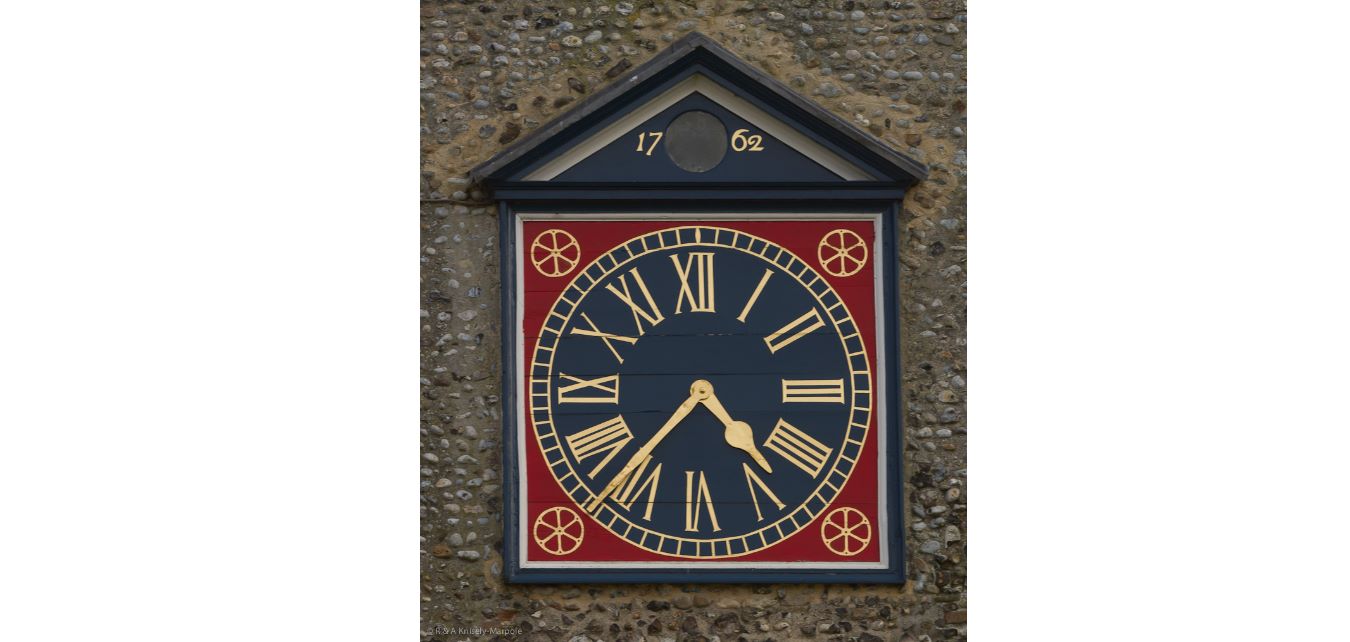 The clock has to be wound every week. A heavy lead weight is suspended on a wire cable wound on to the cylinder on the left hand side of the photo. This provides the power for the strike mechanism. The same system is applied to a similar cylinder on the other side of the clock which supplies power for the time keeping part of the mechanism.
The clock has to be wound every week. A heavy lead weight is suspended on a wire cable wound on to the cylinder on the left hand side of the photo. This provides the power for the strike mechanism. The same system is applied to a similar cylinder on the other side of the clock which supplies power for the time keeping part of the mechanism. 15th Century Nave and Side Aisles
The word Nave is from the latin 'navis' a ship - symbolic of the church carrying Christians through the sea of life.
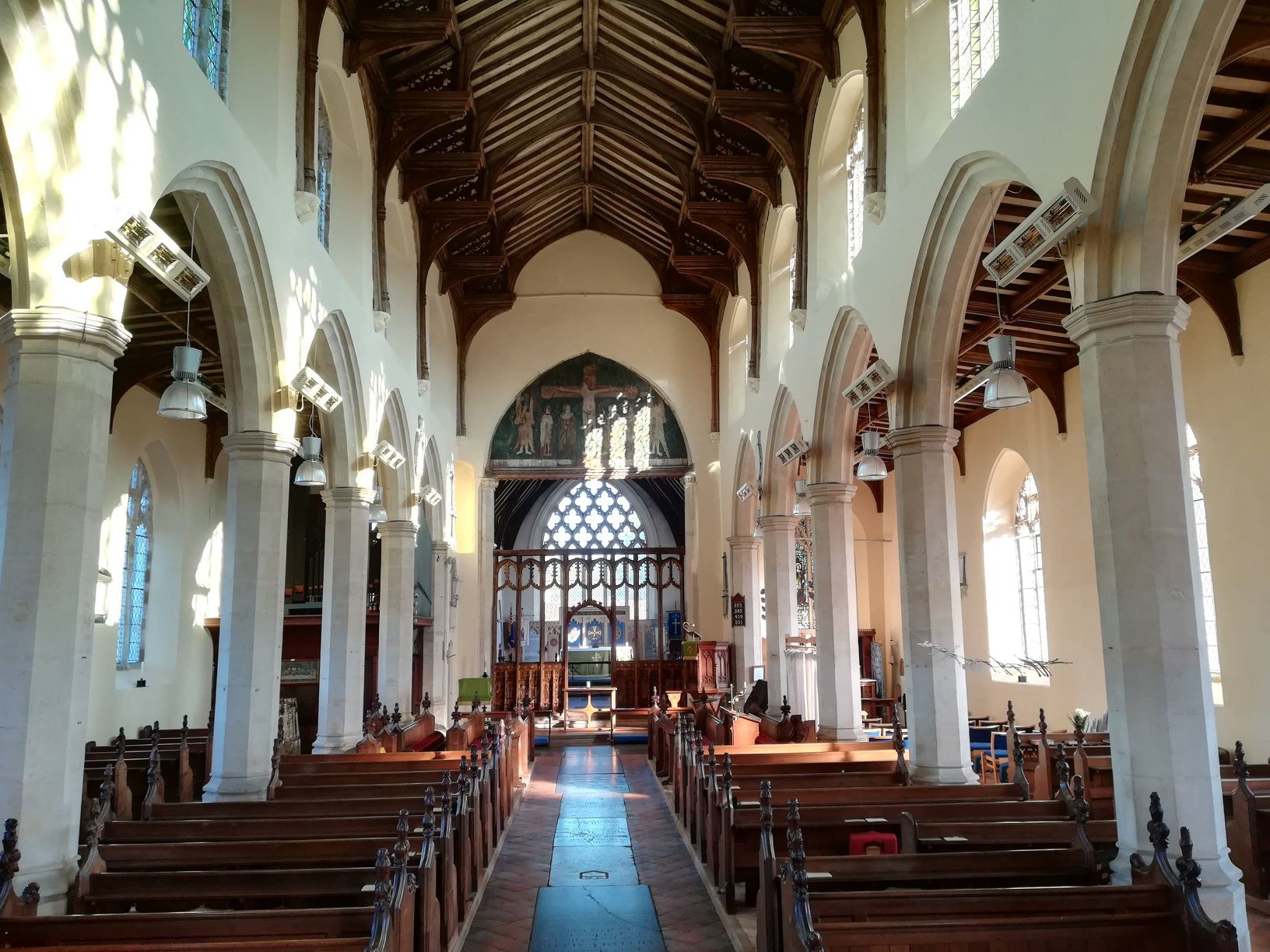 The 14th century Nave and the Side Aisles were rebuilt and enlarged in the 15th century and are very good examples of early "perpendicular" work.
The 14th century Nave and the Side Aisles were rebuilt and enlarged in the 15th century and are very good examples of early "perpendicular" work. Norfolk thrived on the proceeds of the wool trade in medieval times, as did the wealth of St Benets. Which no doubt helped greatly in the building of the church in the 14th century, and later rebuild in the 15th century of the Nave (the main body of the church) and extension of the side aisles in Perpendicular style including a superb hammer-beam roof of oak.
Of the original 14th century building, only the clock tower and the chancel (the altar area) still remain.
The Nave has octagonal columns supporting the 15th century arcades, and a fine hammer beam roof with pierced and tracerie spandrels, every alternate spandrel is in the form of a wheel, denoting the wheel which our patron, Saint Catherine of Alexandria was martyred.
 In 1989/90 under the Vicar, the Rev John J Wilmott, a great deal of restoration and repair work was undertaken to the walls and the pillars, and the floor was relayed.
In 1989/90 under the Vicar, the Rev John J Wilmott, a great deal of restoration and repair work was undertaken to the walls and the pillars, and the floor was relayed. As part of the relaying of the floor a number of memorial stones were moved to their present positions, mostly end to end in the central aisle and across the front of the Nave.
The church also has a number of brasses (inscribed brass plates mounted in memorial stones) which were one of the most popular form of grave marker inside churches between 1300 and 1600.
There are 13 monumental brass plates in all, mostly date from the 1400's. Six of these are in the floor of the centre aisle.
The most interesting is for Thomas of Honing, the Rector for Potter Heigham from 1345 to 1351, and dated 1351. It is set in the floor at the east end of the south aisle near the Lady Chapel Altar, and its date therefore puts it older than the 15th century surroundings in which it now lies.
The inscription is in Latin but translated reads:
" Here lies Master Thomas de Honing, sometime rector of the church of Potter Heigham, on whose soul may God have mercy"
As part of the restoration a new pulpit and oak reading desk were provided by the vicar, and the the old box pews removed and replaced by the present bench pews, with as many of the old oak poppy head bench ends transferred to the new pews as possible.
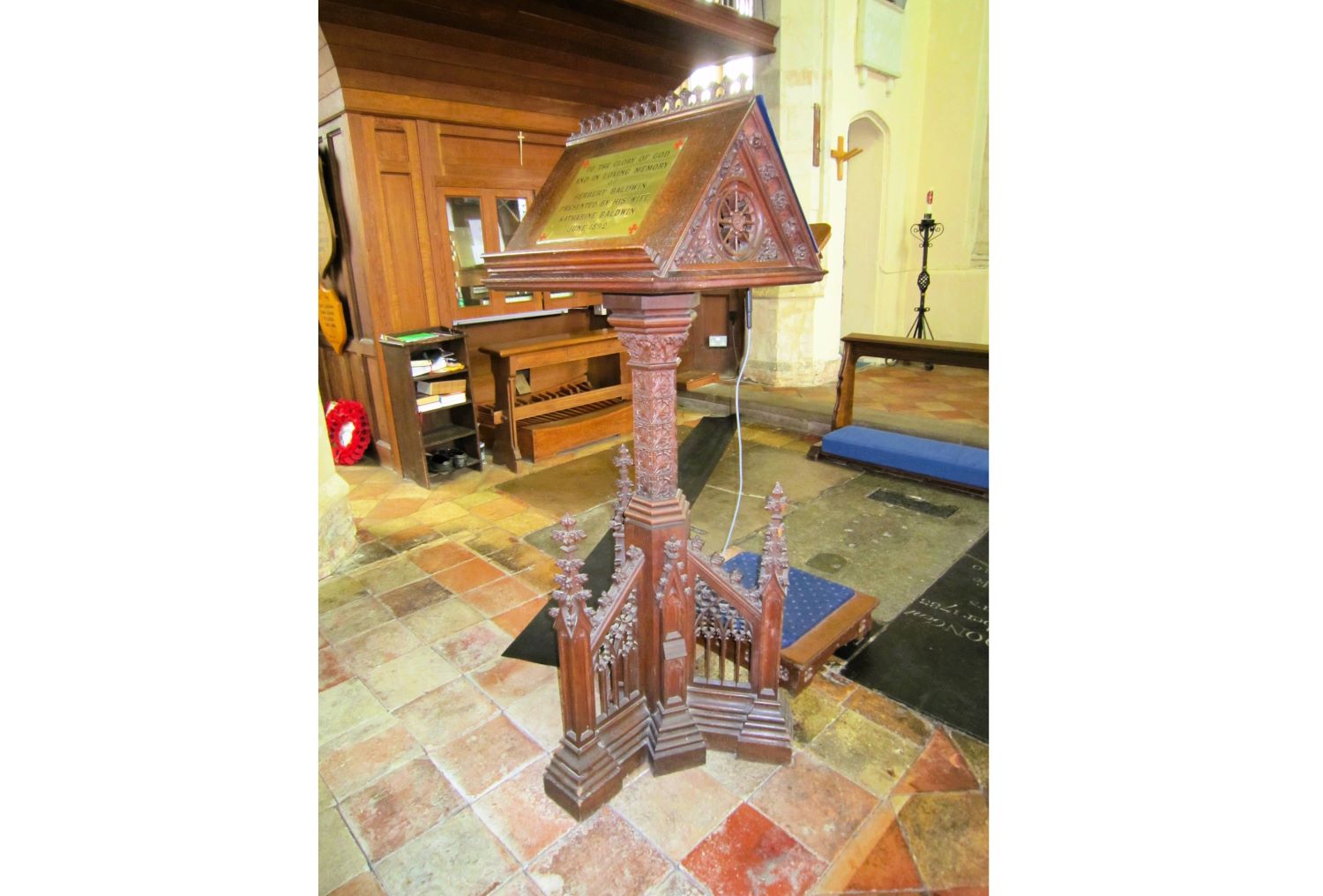
The carved lectern is late victorian and was given slightly later in 1892 by Katherine Baldwin in memory of her husband Herbert Baldwin.
The Rood Screen
The Rood screen forms the lower part of the Chancel Arch, and is one of the finest in the county, and dates from 1493.
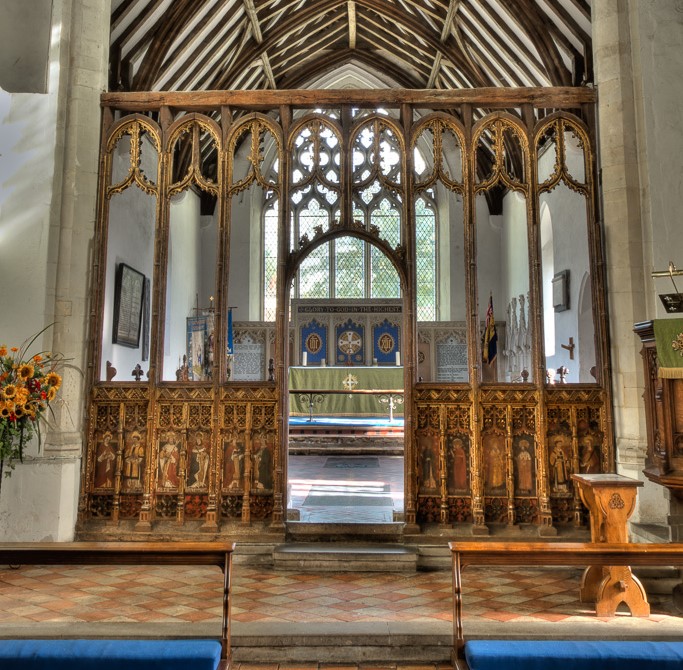
Part of its original function was to separate the Chancel (the domain of the Clergy) from the Nave (where lay people gathered to worship).
All churches had these, usually with a small staircase giving access to the carving of Christ on the cross (the large hole in the wall above the Vestry is where our stairs emerge) - this was to permit the placing of candles before the Rood and to fix the Lenten Veil which covered it all in the run-up to Easter.
If you look at the tops of the pillars either side of the screen you can still see the slots that carried the Rood beams.
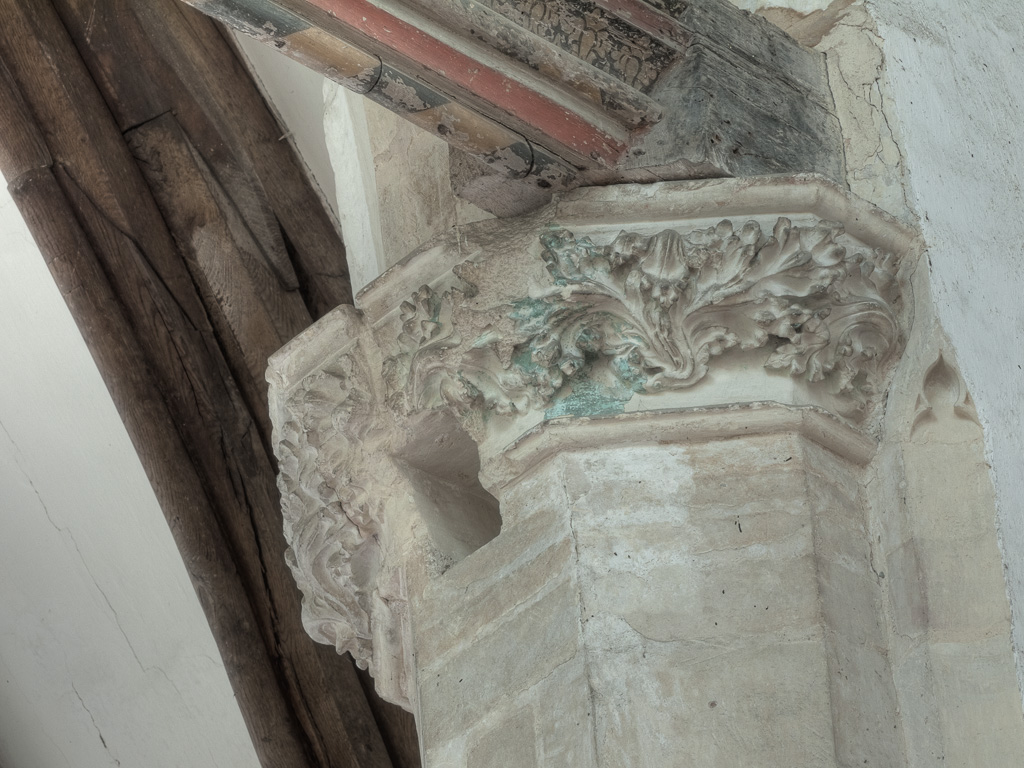 At the top of the pillar on the left you will also find a slightly damaged carved crocodile - which may be some sort of allusion to the local legend of the Ludham Dragon!
At the top of the pillar on the left you will also find a slightly damaged carved crocodile - which may be some sort of allusion to the local legend of the Ludham Dragon! If you look carefully at the beam now crossing below the Tympanum you can just make out the three bolt sized holes which presumably held the original carved figures of Christ, St John the Baptist, and Mary.
The middle rail has a folded leaf inscribed;
"Pray for the soul of John Salmon and Cecily his wife that gave fourteen pounds and for all other benefactors. Made in the year of our Lord God 1493"
It is thought that the previous and much older plain wood screen, was cut down in size and used at the base of the Tower where the new kitchen now stands. It was moved again in 2020 to provide a "handrail" for the new bell ringing platform above the kitchen.
The base is very distinctive. There are twelve painted panels with figures of Saints.
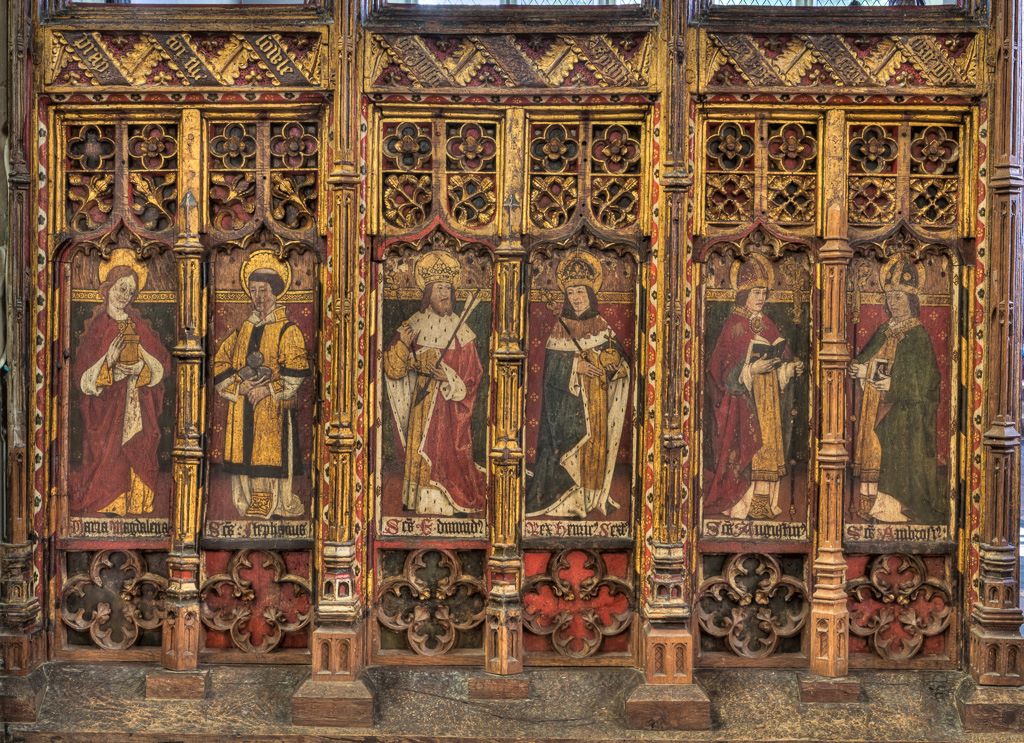 Left Side
Left SideSt Mary Magdalene - with a box of ointment.
St Stephen - the first martyr, with stones.
St Edmond, - King of East Anglia, with arrow.
St Henry VI - with Orb and Sceptre
St Augustine (354 - 430) - with book and Bishop's crozier.
St Ambrose Patron - Saint of Milan, with book and Bishop's crozier.
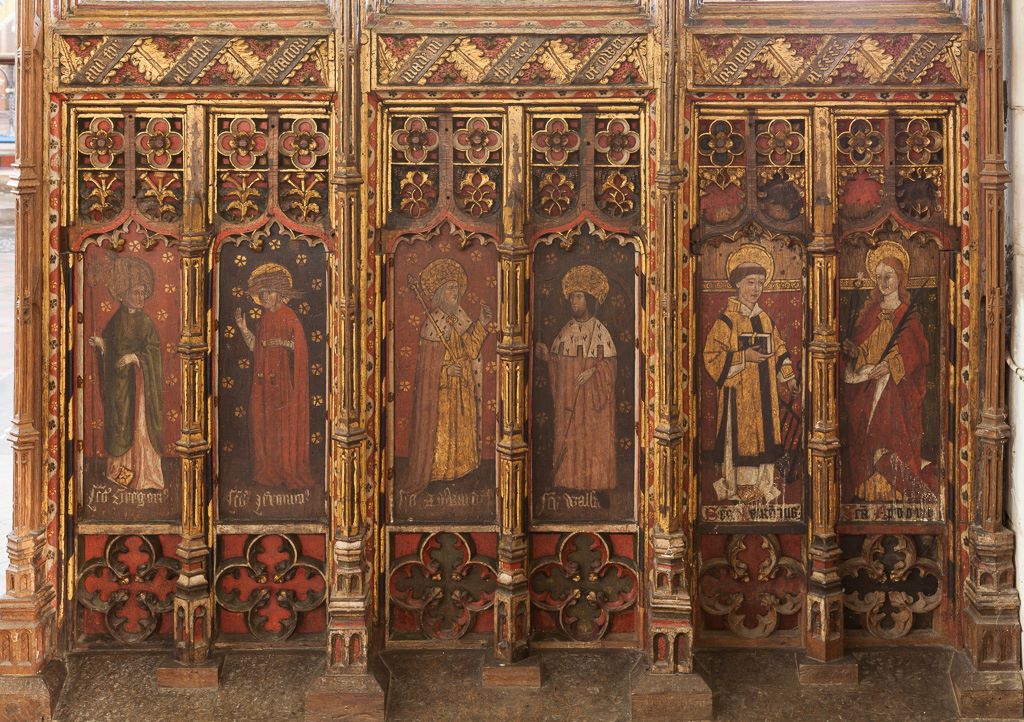 Right Side
Right SideSt Gregory (590 - 604) - Patron Saint of Musicians, students and teachers, whose tiara has been scratched out.
St Jerome (345 - 420) - Theologian, whose Cardinal's hat has been scratched out.
St Edward the Confessor - holding a ring and sceptre.
St Walstan - Patron Saint of farming, with scythe. Born in Bawburgh, Norwich.
St Laurence (225 - 258) - with a book and gridiron.
St Appolonia - Patron Saint of dentists, with forceps.
Of these paintings, four of them, Gregory, Jerome, Edward, Walstan, have been painted by a different artist from the rest.
The Tympanum
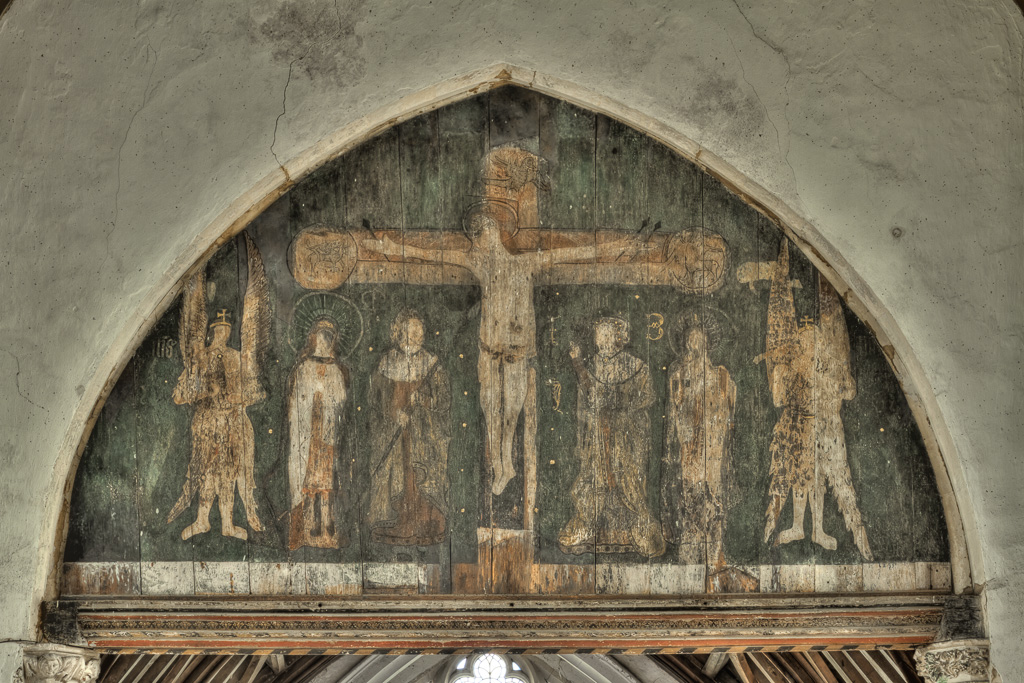 The chancel arch has carved caps supporting a coloured rood beam. Originally, before the reign of Edward VI (1547-1553) this beam would have had on it a Rood or Crucifixion, a carving of Christ on the Cross, with the Virgin Mary and St John on either side.
The chancel arch has carved caps supporting a coloured rood beam. Originally, before the reign of Edward VI (1547-1553) this beam would have had on it a Rood or Crucifixion, a carving of Christ on the Cross, with the Virgin Mary and St John on either side. This would be before the present painted boards, known as a Tympana, were installed.
On the side facing the Nave is Christ on the Cross, St Mary and St John. This was probably painted during the reign of Queen Mary l (1553-1558).
There are thoughts that it might be the same date as the present Rood Screen (1493) or even perhaps originally part of the much earlier Rood screen. This is suggested by the crudeness of the figures painted on the boards, which is readily seen by a comparison with those on the Rood screen panels below.
However a study some years ago by Dr Athestan Riley put forward another reason for the crude artwork. Dr Riley suggested that under Henry VIIIth (1491-1547) the Tympanum was destroyed as being idolatrous, and that on Mary's accession in 1553, haste was made to restore the old glories by the provision of the present Tympanum, which was a copy from memory of the original, by a local craftsman.
More recently there has been a great deal of interest in the age of the Tympanum and academic research into its true age has recently been started.
If the panels are a lot older than previously thought then the Tympanum could be extremely rare and one of, if not the earliest, example in the country.
These Tympana were common at one time but are now rare, and only a few are left. After the Reformation these pictures of the Crucifixion were often painted over with the Royal Arms to prevent, it is supposed, idolatrous worship.
In the case of St Catherine's the Royal Arms were painted on canvas and probably then nailed over the pictures to hide them. This canvas now hangs on the Chancel side of the Tympana, and bears the Royal Arms of Elizabeth I (1558 - 1603) with the inscription "Non me pudet evangelic Christi" (I am not ashamed of the Gospel of Christ) "Vivat Regina Elizabeta".
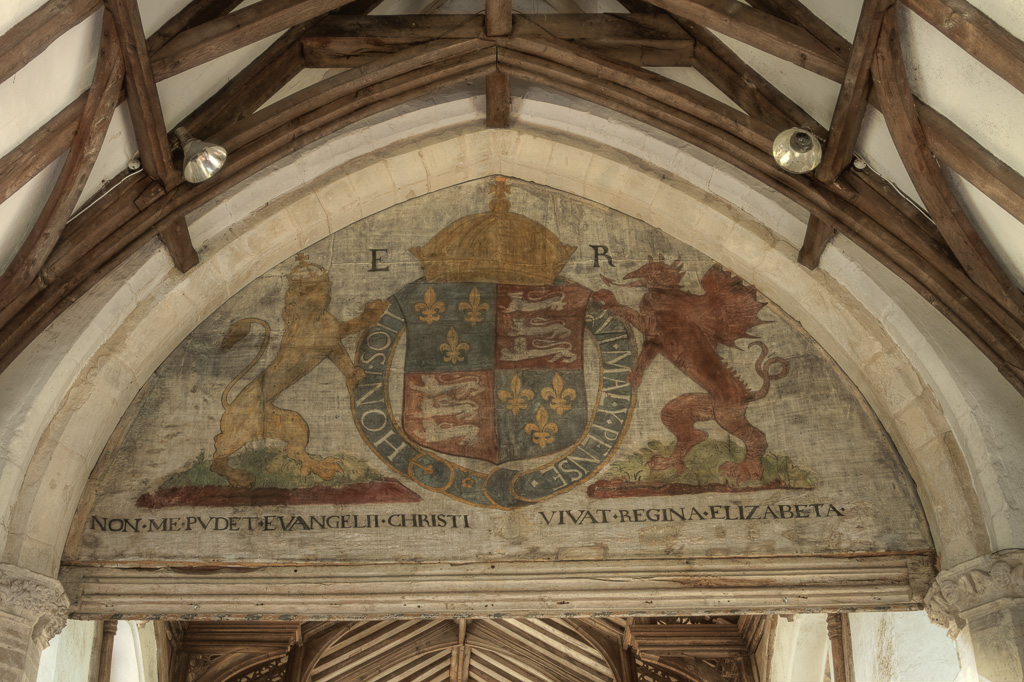 The Tympana boards and painted canvas covering it were at some time, probably the 1600's at the time of Oliver Cromwell (1599-1658), taken down and hidden in the stairs leading to the Rood loft. This was then bricked up and concealed. There they lay for some 200 years until discovered in 1879 during a visit by a group from the British Archaeological Society.
The Tympana boards and painted canvas covering it were at some time, probably the 1600's at the time of Oliver Cromwell (1599-1658), taken down and hidden in the stairs leading to the Rood loft. This was then bricked up and concealed. There they lay for some 200 years until discovered in 1879 during a visit by a group from the British Archaeological Society. The Church Organ
The organ replaced a much smaller one in the 1930's, and came from Ingham church, where it was considered too large for the building.
The organ was originally pneumatic driven but converted to electrical in 1992. It has 3 manual and 6 great stops as well as 7 slow stops and couplers.
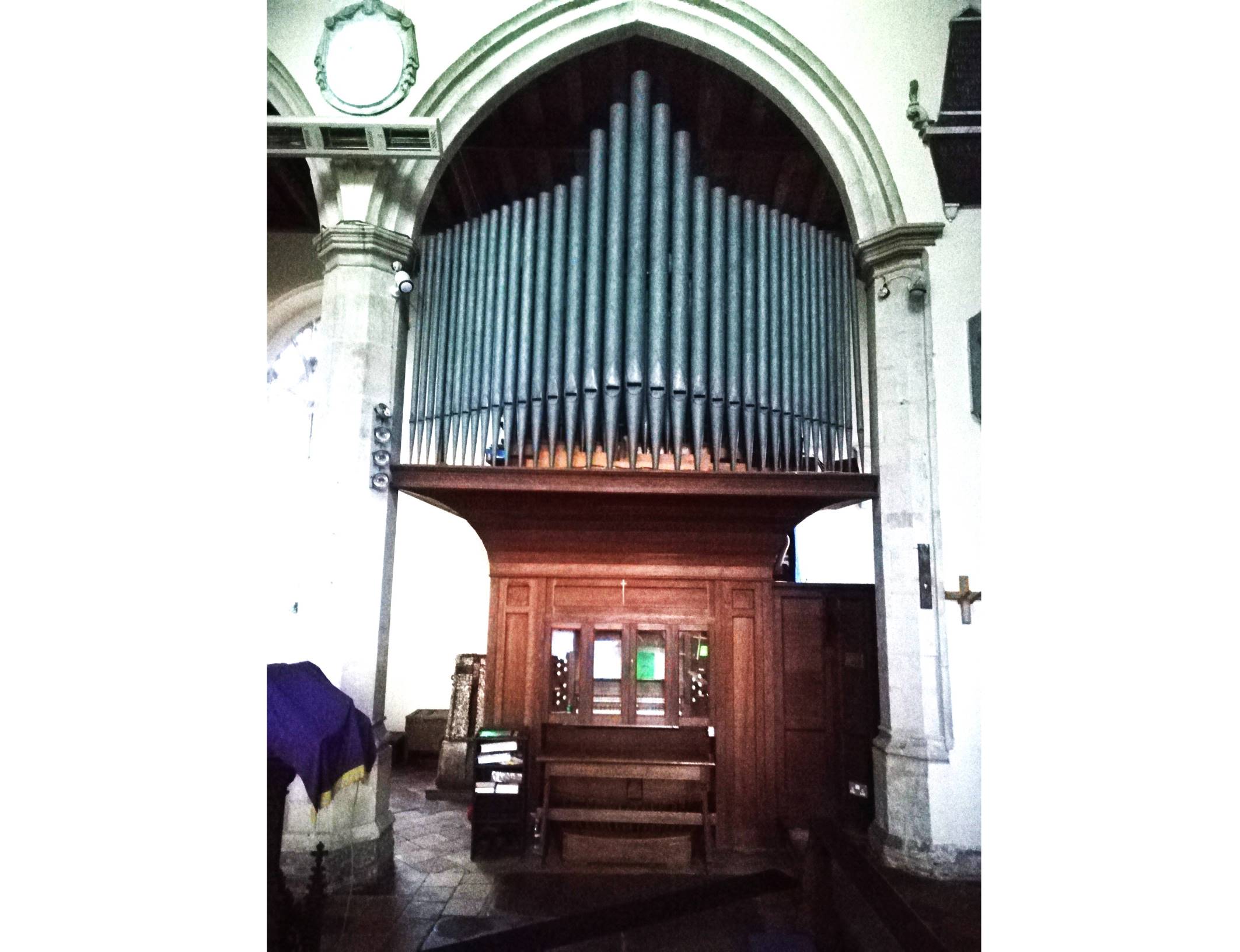
If you are an organist and would like to play our wonderful church organ please contact in advance our Church Organist John Savage, 01692 678654, email johndsavage@ymail.com
The acoustics in St Catherine's are particularly excellent and we have a regular schedule of concerts covering all genre throughout the year.
Recent performers at St Catherine's have included:
Elinore Hanton - Organ Recital, Hayley Moss with Carrie O'Donnell - Popular Classics, Estevao Devides - Classical Guitar, The Fitzalan Consort - Pergolesi's Stabat Mater, The Wandering Minstrels - Gilbert and Sullivan, Paddy's Legs - Irish Evening
Check our webpage, or follow us on Facebook, for upcoming performance details.
The Parish Chests
In the West Aisle next to the Organ can be seen three ancient chests.
The large upright white chest is an iron bound Parish Alms Chest originally to hold donations for the poor of the village and a requirement of the Poor Law of 1552, which directed it have a hole in the top and three locks.
The chest is believed to be 16th century, not later than Edward VI, but it may be much earlier. It stands on a tree trunk base.
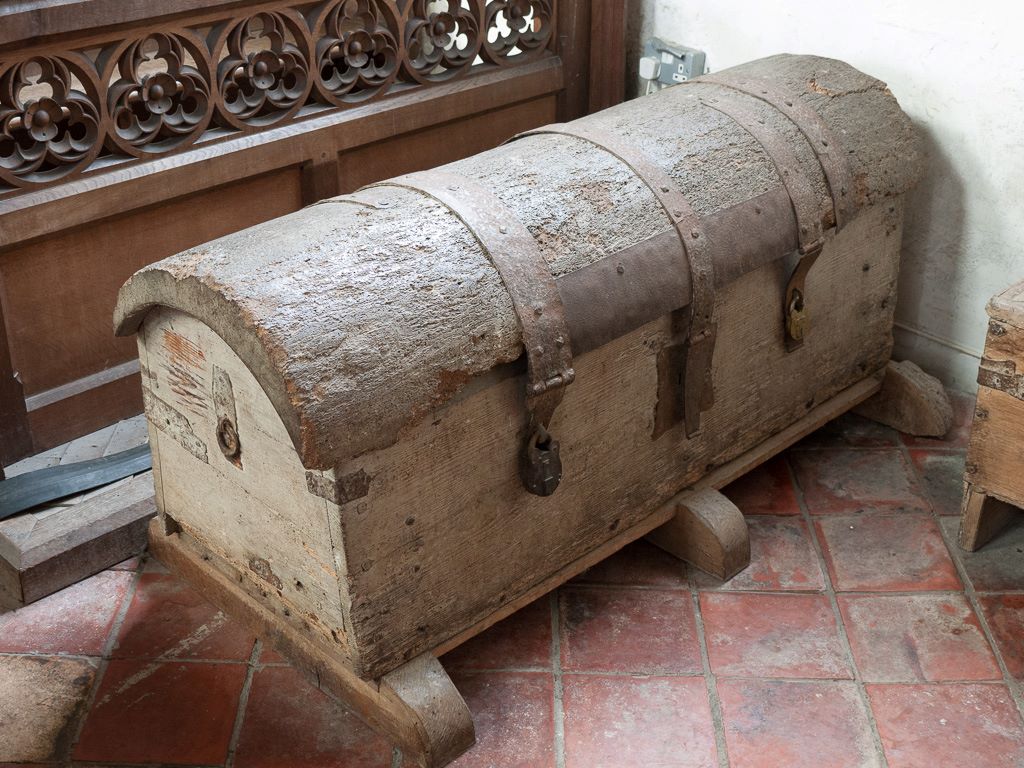 The long one has a semi circular lid made from a hollowed out tree trunk, it has two padlocks, a lock, and handles for carrying. This type could be very early, but this type continued to be made until quite late.
The long one has a semi circular lid made from a hollowed out tree trunk, it has two padlocks, a lock, and handles for carrying. This type could be very early, but this type continued to be made until quite late. World War Memorial Sheilds
The Memorial Sheilds list the names of villagers who died in World Wars 1 and 2. They also appear on the Village War Memorial just inside the church gate.
God bless all who lay their lives down for others. May we build a world that makes their sacrifice worthwhile.
George Washington
In November 2017, Richard Weaver from the National Society of the Washington Family Descendants in the USA, visited Ludham and presented this plaque to St Catherine's Church.
The Sotherton (also spelled Sothern and Southerton) family came originally from Holme on Spaulding Moor (sometimes Spalding) in Yorkshire. We think Sir Thomas is buried in the churchyard at St Catherine's although his grave has no marker. Although he may be buried at Framlingham Castle where his son was born.
Nicholas Sotherton owned the Stranger's Hall in Norwich and was at various times Mayor and Sheriff. Three Sothertons were Mayors of Norwich. The name Augustine carries on down the family tree to George Washington's father.
Interestingly, Lady Elizabeth had another famous descendant. She is the thirteen times great grandmother of H.M. Queen Elizabeth II.
If this was not enough, she was also related by marriage to Sir Winston Churchill and Diana Princess of Wales.
The Garrett Family Tree
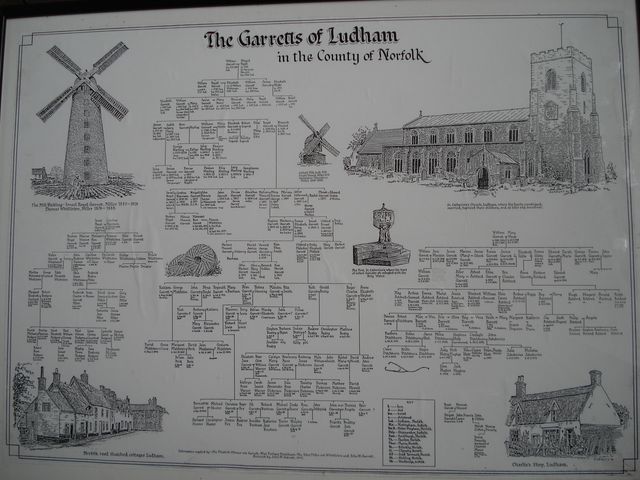
Of all the enquiries the Ludham Archive Group receive about families connected to Ludham, enquires about the Garrett Family is the most common.
Since the creation of the family tree on display a number of small errors have been discovered. For more information about the Garrett family, and to view other family trees of Ludham visit the Ludham Archive Group's web site at https://www.ludhamarchive.org.uk/family.htm
The Chancel
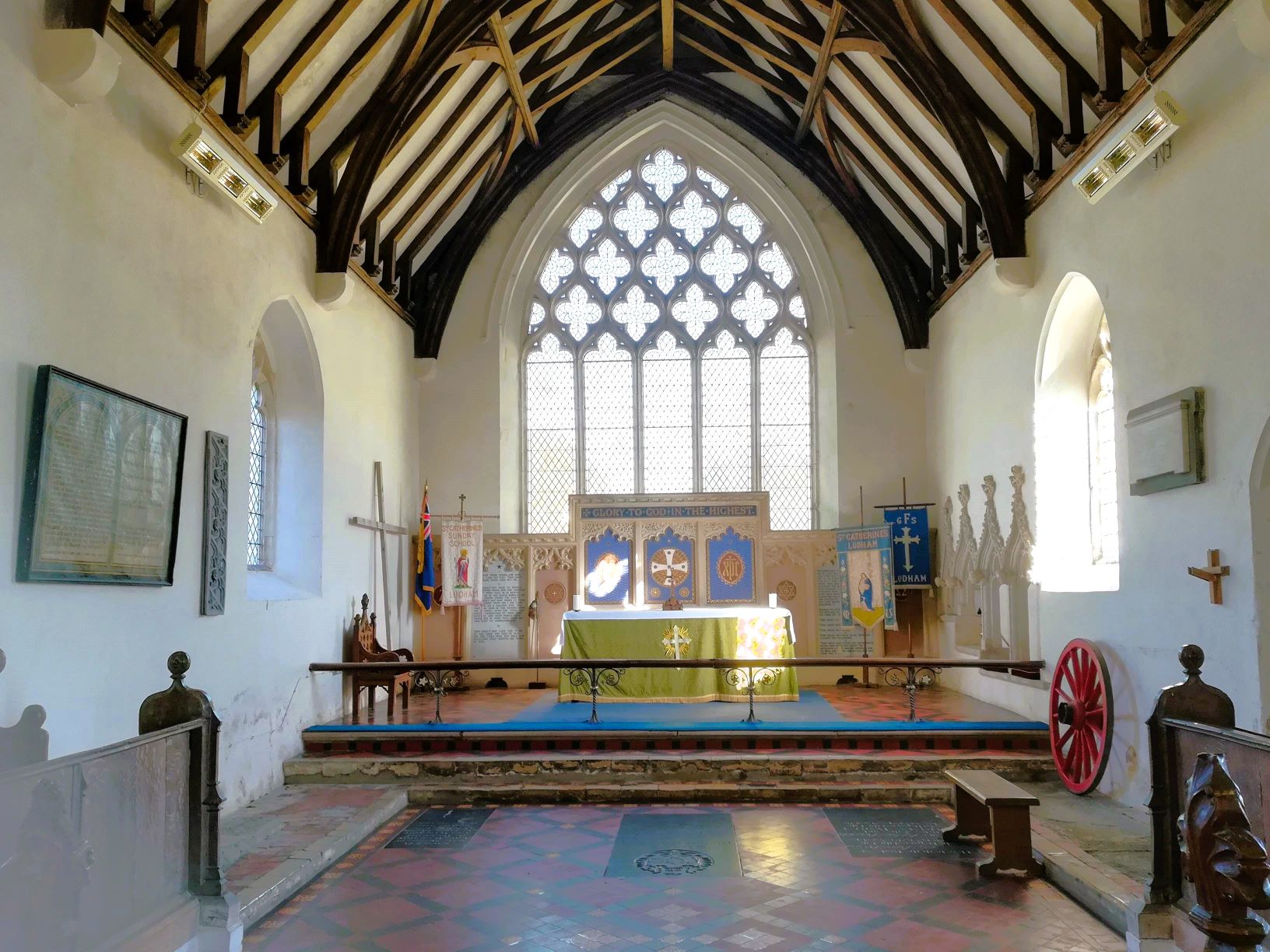 The Chancel (the area forward of the Chancel Arch) is the oldest part of the Church and would originally have been thatched. It is thought likely that there was a church of some sort on this site from the 8th or 9th centuries.
The Chancel (the area forward of the Chancel Arch) is the oldest part of the Church and would originally have been thatched. It is thought likely that there was a church of some sort on this site from the 8th or 9th centuries. The Chancel was built during the 14th century and with the exception of one window on the south side is in purely Decorated style, the type of architecture and window tracery that was in use from just before 1300 until about 1350. This side window, beside the priest's door, is a later addition in early Perpendicular style.
The Chancel floor is tiled with some modern and some medieval tiles.
The Priest's Door
The door on the south side of the Chancel is known as the Priest's Door, and leads into the churchyard. Outside the hood mould over the door has two small medieval heads.
On the buttress next to the door is a scratch dial, a pointer inserted into the central hole would have shown the time of the next mass.
The Sedila
The finely graduated 14th century Sedilia or seats on the south side of the altar were for the clergy officiating at the Altar. During medieval times these would have been used by the Priest, Deacon and Sub deacon.
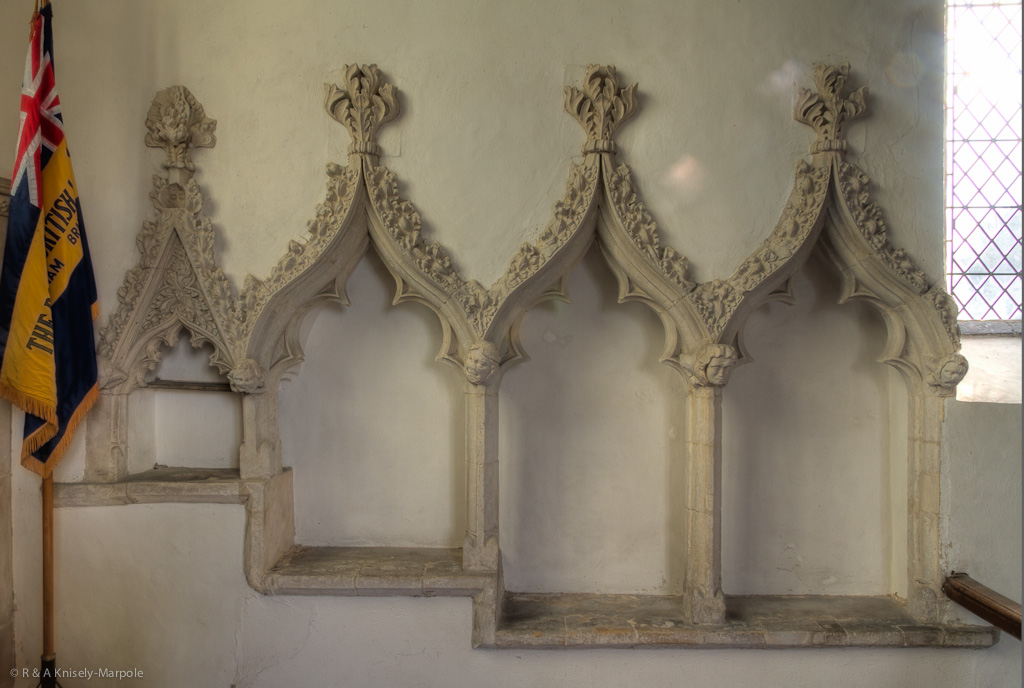
The Piscina
To the left of the Sedilia is a canopied niche called a Piscina, or basin. This is 14th century and was used for the washing of hands and the chalice during mass.
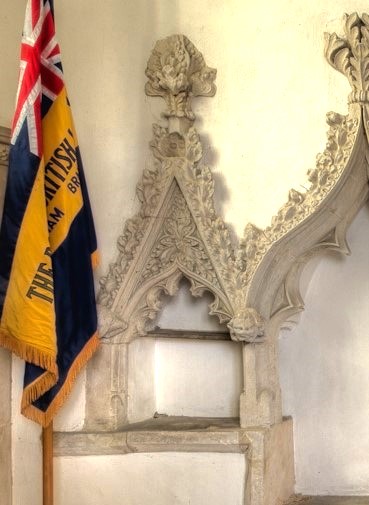
The Reredos
The large ornamental stone screen called a Reredos behind the altar is Victorian, and was given by an anonymous donor in 1883.
The Ten Commandments are now carved into the marble slabs on the wall to left and right of the Reredos.
The Altar table itself, which is a modern oak table, was made by Pat Thrower, a Ludham carpenter, in 1957, and replaced an earlier Stuart table.
The Cross
The wooden cross is often used during church services involving processions. This photo shows the cross being carried through the village from Ludham Methodist Church to St Catherine's for a joint service during the Easter Walk of Witness.
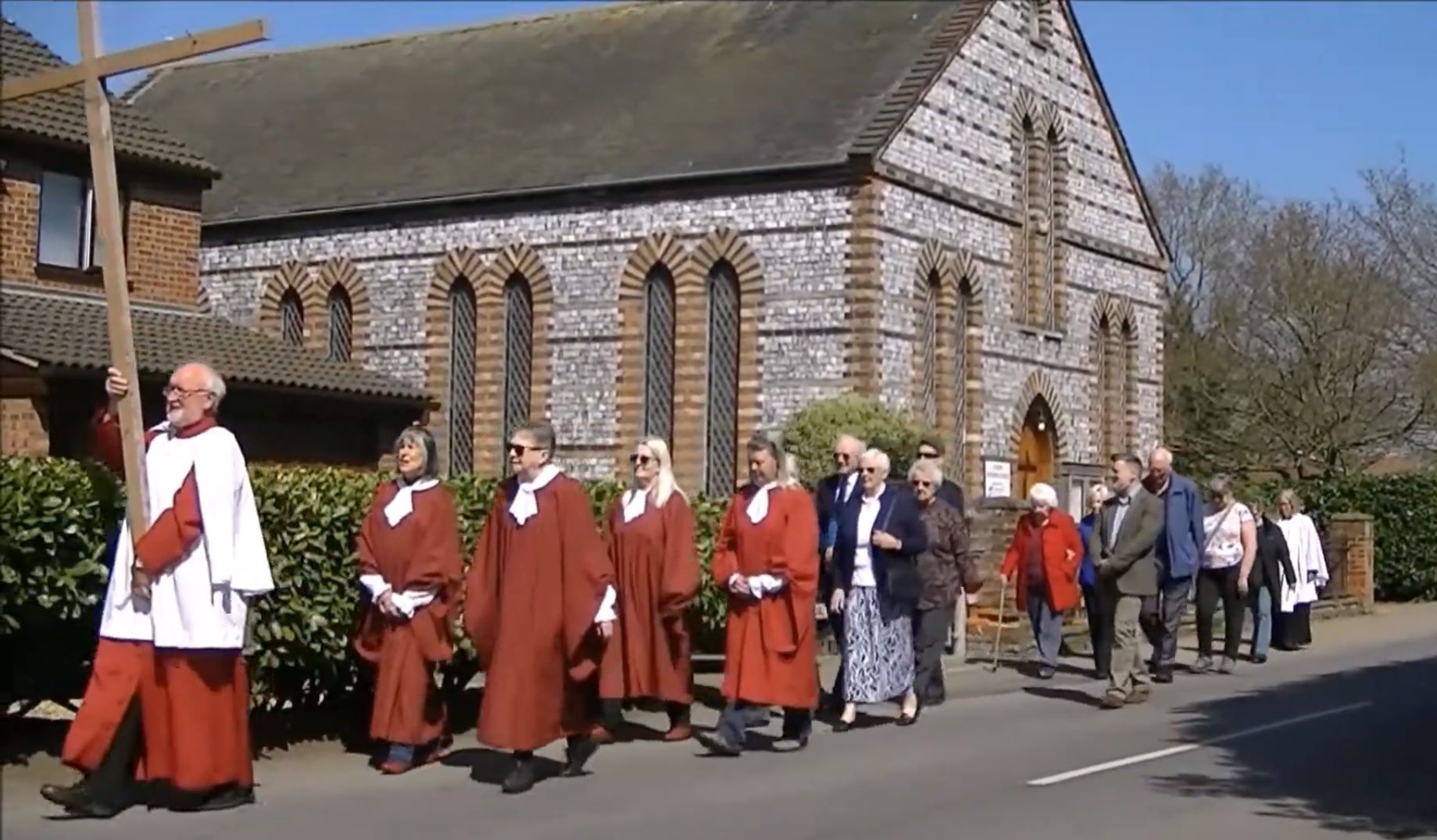
The Wheel
The wooden cartwheel represents the wheel on which St Catherine was martyred and is used occasionally during church services. This photo shows it being used for candles during a remembrance service.
Ludham Jubilee Map 2002
In 2002 as part of a Jubilee Year community project a group of villagers got together to create a textile project. The result was a large three part map of the village. The central portion of which is in the Chancel and shows the village. The two side panels are located next to the South Door and display buildings in the village as well as the many logos and symbols of village organisations, clubs, and schools.
The making of the tapestry generated huge interest in the village and its history. Following which the Ludham Community Archive was formed with the aim of creating a lasting digital archive of Ludham village.
The Ludham Community Archive meet twice a month to review new material, and have collected over 300.000 photos and documents so far, with more being added each month, along with over 250 videos (many available on their You Tube channel).
To find out more about the Archive, to view some of their material, and to find out about their twice monthly meetings and very popular Winter Walks visit https://www.ludhamarchive.org.uk/index.htm
The Lady Chapel
During Medieval times, there were often other alters in churches, in addition to the high altar. At St Catherine's there is a second altar where the present Lady Chapel is, and there was possibly another at one time in the opposite aisle where the organ now stands.
The three figures represented in the glass are:
St George - Patron Saint of England.
St Benedict - Who detailed the rule of life which became the pattern for Western monasticism, and whose order built St Benet's Abbey close by.
St Catherine - To whom this church is dedicated.
Below the central figure of St George an angel holds a panel reading "To the glory of God and in memory of", hidden by the top of the Alter wording at the base of the three figures reads :
"Thomas Slipper Churchwarden 1873 to 1887 Died 26th Decr 1918"
"Mary Ann Gooch Slipper his wife died 2nd Aug 1903"
"and of Thomas Slipper Churchwarden 1806 to 1856 died 27th Aug 1856".
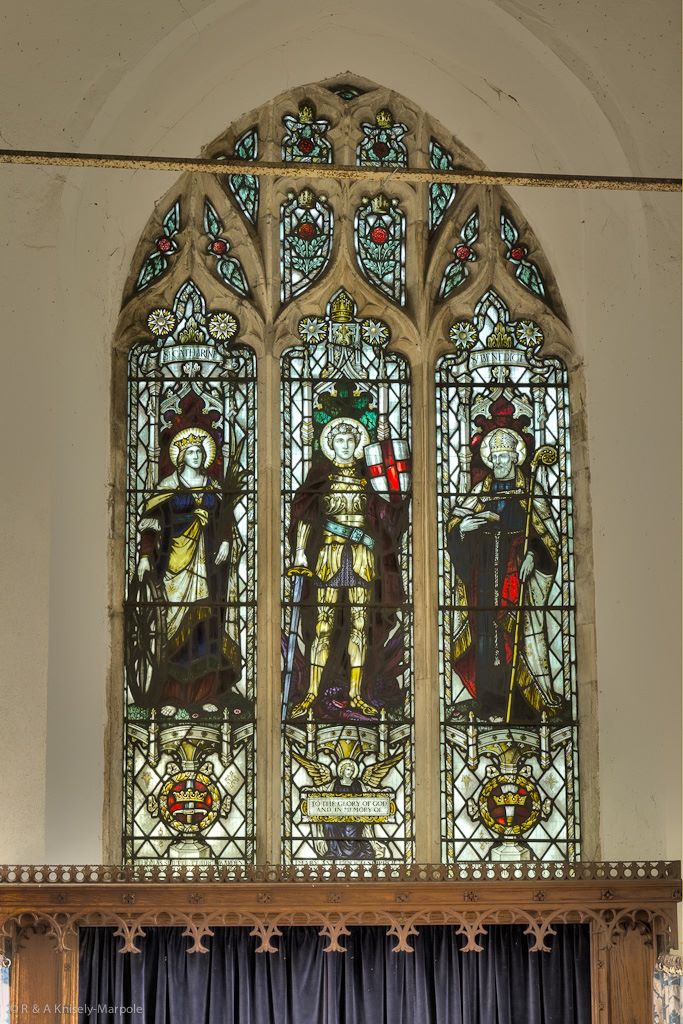 It is thought that the Lady Chapel was originally the private Chapel of the Lord of the Manor, the small door close by in the south wall being used to give easy access to the East Gate of the Churchyard that leads to the Manor House.
It is thought that the Lady Chapel was originally the private Chapel of the Lord of the Manor, the small door close by in the south wall being used to give easy access to the East Gate of the Churchyard that leads to the Manor House. The Projecting Hand
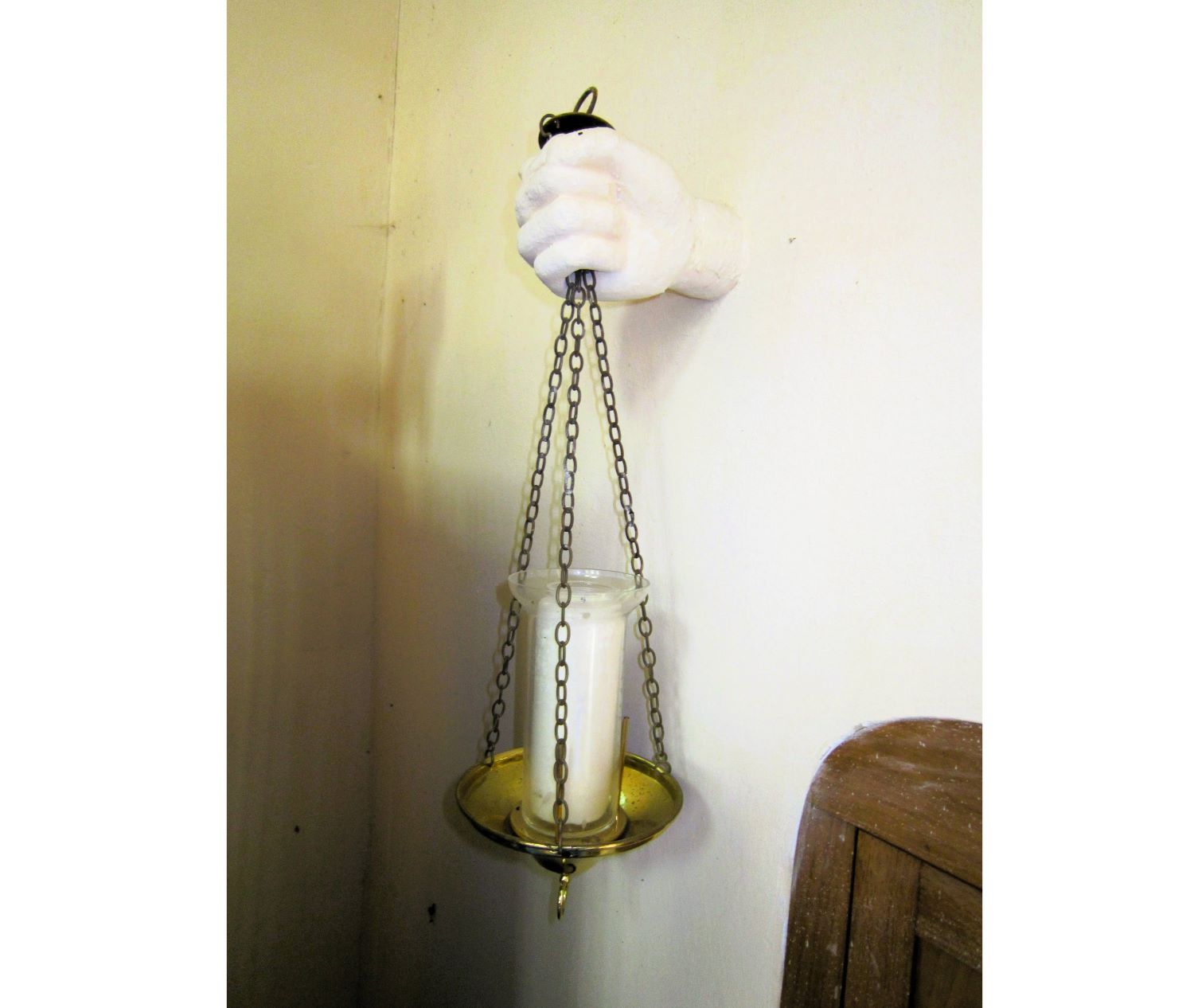
On the right hand wall of the Chapel you will see the Projecting Hand. In 1898, when the Hagioscope (Squint) on the left of the Chapel wall was unblocked, the Hand was discovered lying inside. The socket hole was found in the wall where the hand is at present.
There are various explanations for the hand, though most probable is that it was for the Sanctus Bell rope, the bell being outside on the roof; a Sanctus Bell being rung at the more solemn parts of the Mass (visible through the "squint hole") so that people who were not inside church would pause and pray at this holy moment of the mass.
Votive Candles
In front of the Lady Chapel on the south wall are votive candles for use by visitors and congregation.
Here if you wish you can light a candle for prayer or in remembrance.
Lighting a candle can be a way to help in prayer, or to ask for God's help, either for yourselves, a loved one, or someone you know is in difficulty and needing God's support.
If someone you know has died recently or long ago, lighting a candle can also often help us pause, pray and think of them for a few moments.
Whatever is going on, make space to pray in your life.
You can light a candle at home, or online on the Church of England web site (link below). The process is simple. private and totally anonymous, there are no login, registration, or any other details asked for.
The North and South Porches
The North and South Porches are both 15th century with inner door arches of plain 13th century work, which makes these arches one of the oldest parts of the church. It is not known if they are in their original positions or just reused during the 15th century re-building.
In 1889 a new oak door was installed to the North Porch, keeping the old lock and hinges.
A carved dedication on the South door (Choir Vestry) reads
To the Glory of God and in Pious Memrory of Richard, Robert and Martha from their Sister Emily Clark 1903
In 1903 the room over the South Porch (the Parvise) was restored and the stair-turret up to it was re-built. In medieval times these little rooms were sometimes used as a schoolroom.
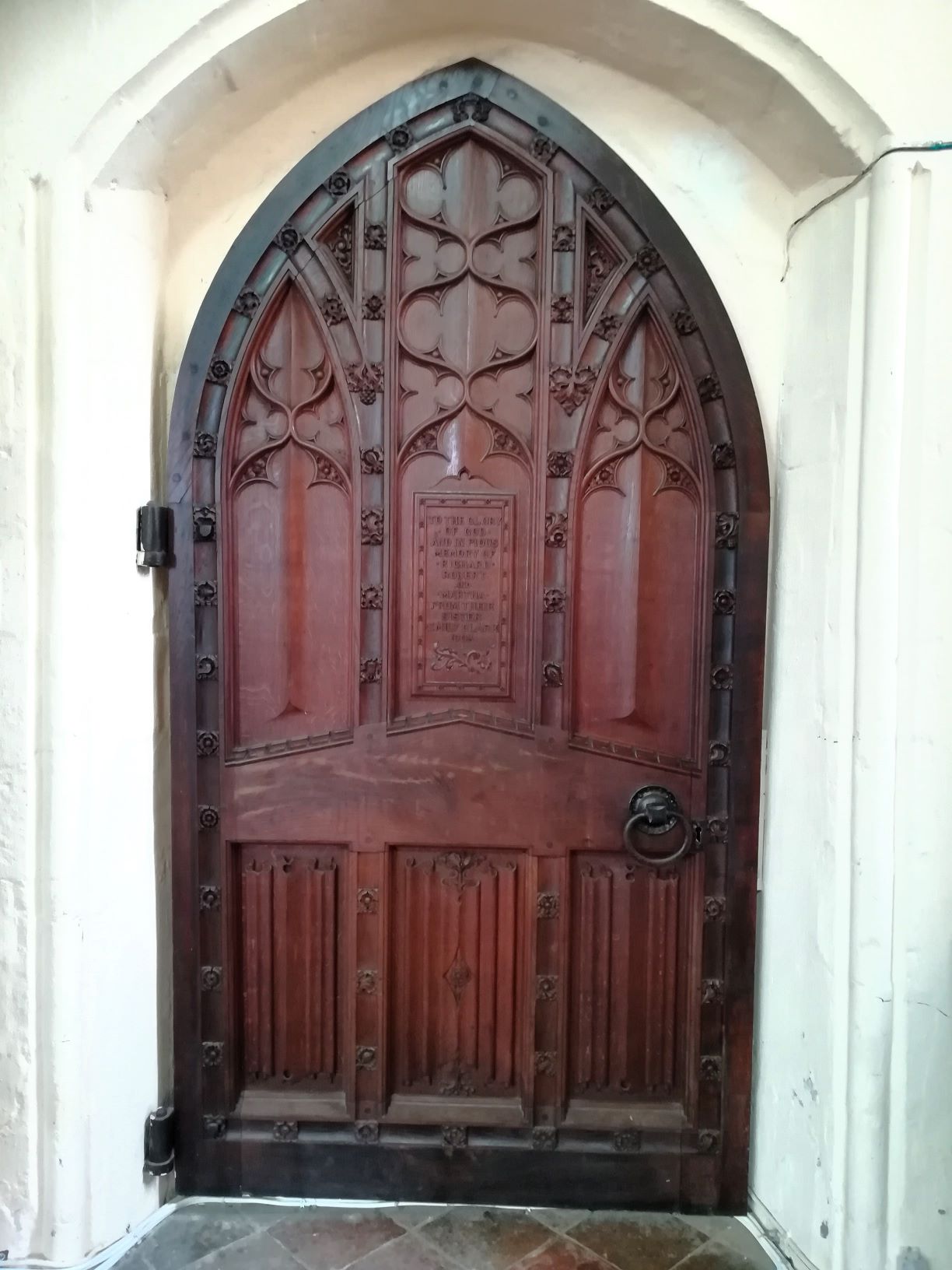
Ludham Jubilee Map 2002 Side Screens
The central portion of the Jubilee Map is in the Chancel and shows a map of the Village.
The two side panels next to the South Door display buildings in the village as well as the many logos and symbols of village organisations, clubs, and schools.
To find out more about the subjects on the side panels, and the people who made them booklets are available as free downloads from the Ludham Archive website using this link - Ludham Archive downloads
Vicars at St Catherine's
At the rear of the Nave to the left of the kitchen, is a board listing all those Vicars who have served at St Catherine's since 1214.
We hope you have enjoyed your visit to St Catherine's.
If you would like to make a donation to help with the running costs of St Catherine's please place cash in the top slot of the green safe by the North Door.
Cards can also be scanned using the Good Box device in front of the notice board.
Or you can click the link below which take you through to online donations.
Thank you for your support
Sunday Morning Worship
St Catherine's is open for regular Sunday Morning Worship every Sunday at 10amHoly Communion takes place on the 2nd Sunday of every month at 10am
St Catherine's church is also open to both visitors and for personal prayer and reflection every day from 10:00am until 4:00pm during winter months.
All are welcome.
Please check the Waterside Group opening page for details and updates to all church services taking place in the Waterside Benefice.
THE FRIENDS OF ST CATHERINE'S CHURCH
The Friends Association was founded in 1993 to assist in the maintenance of the fabric of the Church and Churchyard for the benefit of the public.
They have been very successfull in raising funds for the church building, most recently to contribute to the costs for the repair of erroded stone work and windows in the nave, to update the heating, and to provide kitchen and toilet facilities for use during concerts and events in the church.
For details of upcoming events, to join, or volunteer to help at events, visit the Friends of St Catherine's Facebook page
Link - Friends Facebook page
Or contact on email at foscludham@gmail.com or call 07843435100
The Friends of St Catherine's Ludham is a registered charity - Charity no. 1041950
This guide is provided by
St Catherine's PCC, Ludham
Acknowledgements
The main text and source for this guide has been Joan Snelling's 1999 "Notes on Ludham Church", to which has been added colour photographs, updated text and additional information that has since become available. Further valuable sources used were Ludham PCC's "A Guide to St Catherine's", and the Ludham Community Archive's web site and photographic archive.
Terry McAree - Editor
2024